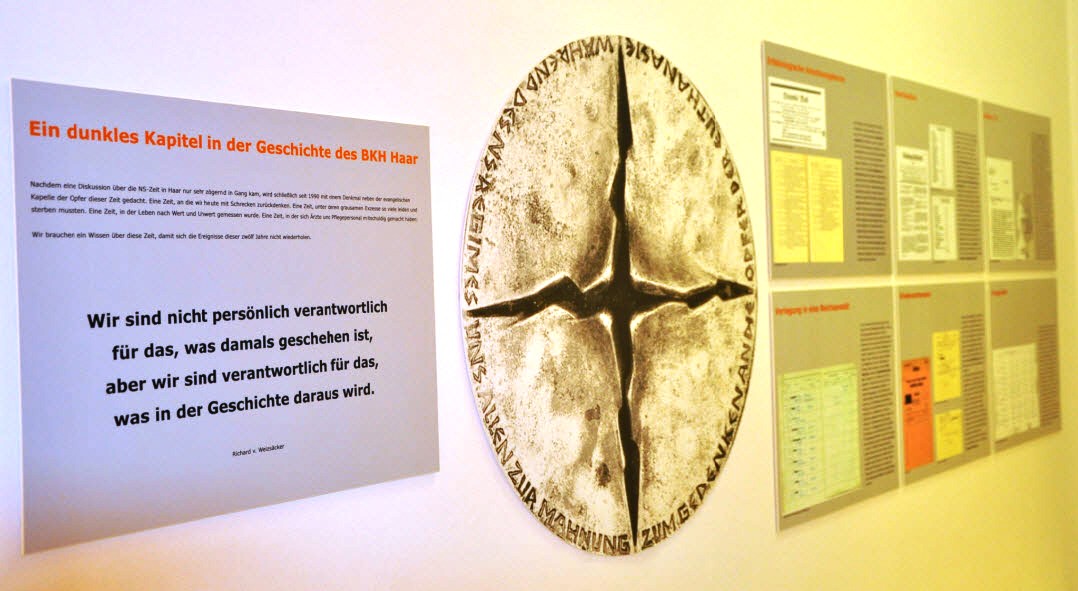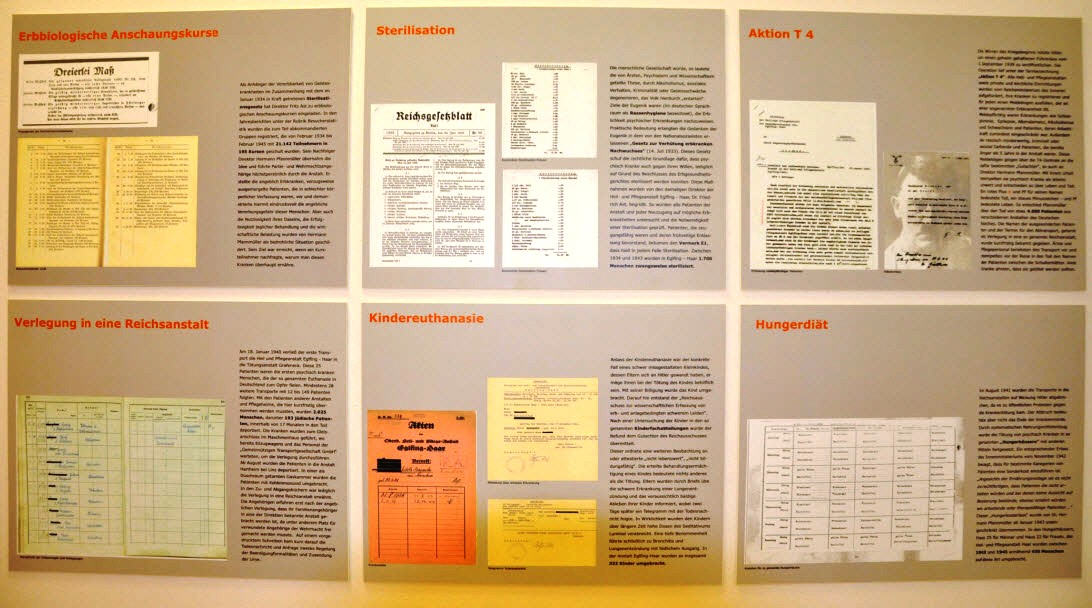Home
Eglfing-Haar (Oberbayrische Kreis-, Heil- und Pflegeanstalt
Eglfing-Haar)
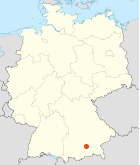
The Kinderfachabteilung in Eglfing-Haar existed between
October 1940 (as
the first of three in Bavaria and the third one overall) and
May 1945. Its medical director
was Dr. Hermann Pfannmüller,
and the physicians responsible for the special children's
ward were Dr. Gustav Eidam, Dr. Fritz Kühnke, and Dr. Ernst Wentzler.
Dr. Pfannmüller
was sentenced in 1951 in Munich to a five-year prison term and died in
1961. Dr. Eidam committed suicide in 1945. Dr. Kühnke
also traveled to the Kinderfachabteilung Wiesloch to kill children
there (see Wiesloch); after the war he was a pediatrician in Hamburg,
and the investigation against him was stopped in 1969.
Dr. Wentzler operated a private children's clinic in Berlin-Frohnau
after the war and died in 1973.
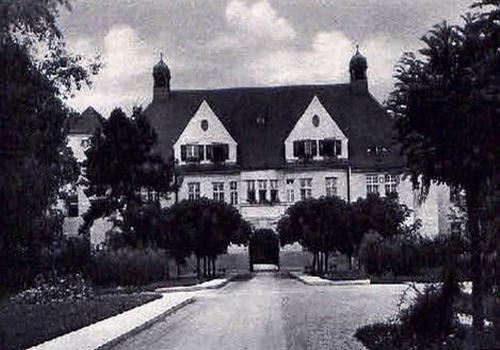
332
children died in the special children's ward.
| The clinic Eglfing-Haar also has a special
significance due to the fact that on Jan. 18, 1940, a group of male
psychiatric patients left the clinic for Grafeneck and were murdered there, likely on the very same day. The
first name on the transport list of this first group systematically
murdered in a gassing facility of the program T4, was, as first reported by Henry Friedlander, Ludwig “Israel”
Alexander - a German Jew. (The Nuremberg trial records that contain the
picture of the transport list are now public record.) |
Source: Harvard
Law School Library, “Nuremberg Trial Project,” Item No. 109. Available at http://nuremberg.law.harvard.edu/php/pflip.php?caseid=HLSL_NMT01&docnum=209&numpages=1&startpage=1&title=List+of+patients+transported+from+the+Eglfing-Haar+asylum+[in+the+euthanasia+program].&color_setting=C
Soon after the end of WWII the American major Leo Alexander,
commissioned to produce a report for the Combined Intelligence
Objectives Sub-Committee, visited Eglfing-Haar and noted his impressions as
well as the facts he established in his report (see here: 1, 2, 3, 4),
which he concluded in August 1945. The full report contains an
extensive appendix not included in the version on the Internet (see
Alexander 1945). The appendix contains copies of extensive records
concerning "euthanasia," including children.
Dr. Gerhard Schmidt, who had been appointed acting medical director for Eglfing-Haar at the end of the war, collected various
records and sought to publish them in a ms. that established what kinds
of events had happened at Eglfing-Haar. This ms. constituted the
first-ever detailed German documentation of "euthanasia" crimes in the
postwar period for a specific locale, including "children's
euthanasia." He also gave the first speech on the subject matter by a psychiatrist after WWII in a radio address to the
public, on 20 Nov. 1945. Dr. Schmidt
efforts of publishing his findings in the ms. as a book came to fruition only in 1965.
Things began to change in the mid-1980s, when residents among the clinic's physicians noticed that Dr. Pfannmüller's picture
was missing among those of former directors of the clinic in the
administrative building - but without any explanation. Also, the newly appointed Protestant reverent K. Rückert at
the clinic noticed that civilian (including) "euthanasia" victims
of war were not mentioned during the memorial at the warriors'
memorial on the annual national day of mourning (Volkstrauertag),
and Rev. Rückert organized a procession
on the eve of the national day of mourning in 1985 to address the
"euthanasia" past of the clinic.
Yet
local resistance to the commemoration of "euthanasia" victims
continued, including but not limited to members of the municipal
council. During the discussion some even denied that "euthanasia"
crimes had been committed at Eglfing-Haar. After a vote a bare majority
of council members in favor of a plaque to commemorate the events, in
1987 such a plaque, as proposed by Rev. Rückert, was placed next to
the existing warriors' memorial. It reads: "For the victims of
persecution, Euthanasia, war, imprisonment, displacement. The community
of Haar." A reference to Dr. Pfannmüller was added to the gallery of directors.
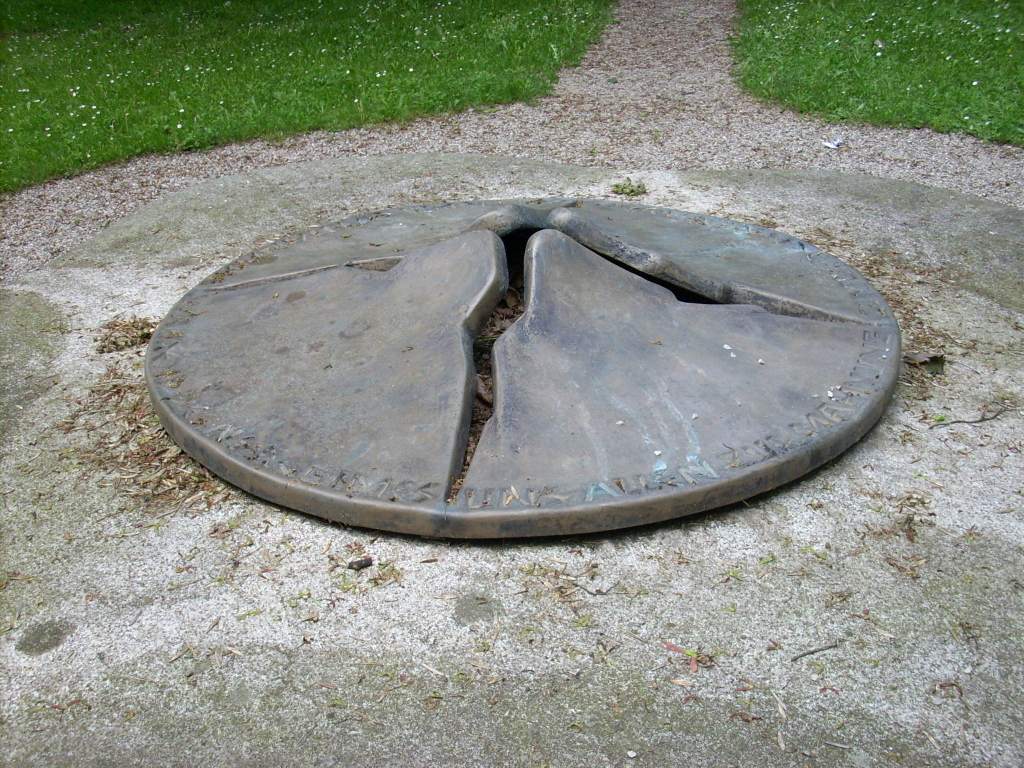
On
the initiative of physicians at the hospital a memorial
created by the sculptor Josef Gollwitzer was placed next to the
Protestant chapel in 1990. The occasion was the 50th anniversary of the
first transport of patients to the T4 killing facility
Grafeneck. The bronze plate has the inscription "In
memory of the victims of Euthanasia during the time of National
Socialism and as a warning." Children's
"euthanasia" is not separately mentioned there, but a display close to
the memorial displays the inscription and the following
additional
text: "On 18 January 1940 the first patients were sent off for
extermination. 50 years later the dedication of the memorial occurred.
Denial, forgetting, and repression of these acts of violent do not
result in liberation. Only the deliberate look into this dark mirror
enables us to decide and act freely and prevents us from incurring
guilt once again. On the order of the National Socialist government in
1940-41, as far as is known, 924 patients at Eglfing-Haar and 746
people who had previously lived at other institutions were
transported to a facility of death. At least 332 children fell victim
to a systematic killing by means of an overdosage of sedatives between
November 1940 and May 1945. From 1943 to 1945 429 patients died in
so-called 'hunger homes' as a result of receiving a special diet
without fat or protein. Detailed documentation [is
available] in
the museum of psychiatry."
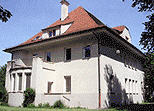 Source: http://www.bezirk-oberbayern.de/showobject.phtml?La=1&object=tx|379.2695.1&sub=0
Source: http://www.bezirk-oberbayern.de/showobject.phtml?La=1&object=tx|379.2695.1&sub=0
After earlier attempts to establish a museum in 1980 and 1984 did not materialize, in
2005, on occasion of the centenary of the foundation of the clinic, a museum of psychiatry opened on clinic property, based on the efforts of clinic personnel in the nursing department. The
museum documents the 100-year history of the clinic and contains such things as a reconstructed living room, parts of an
isolation cell, and medical equipment. In one room it addresses the NS-period, which
includes references to children's
"euthanasia." By 2008, the museum had welcomed its 5,000th visitor, and
it expects to have an annual number of 2,000 visitors over the next few
years, drawing from students, patients, political groups, and members
of civic and charitable organizations.
There is also an art installation in the stairway of the building
housing the museum, entitled "Let me fell your life." There has also
been a reading from a novel, "Der Blechsoldat," by writer Marianne
Ach.
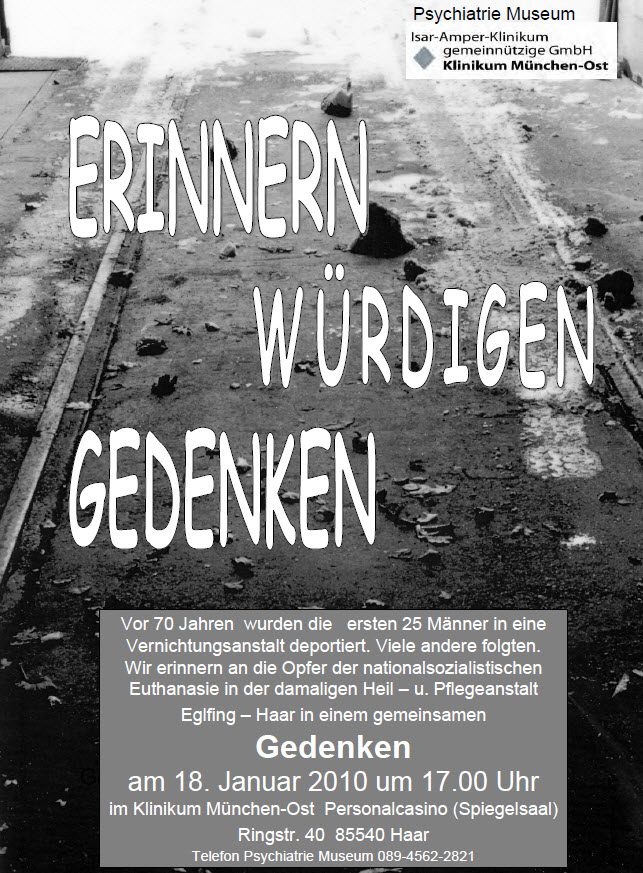
On January 18, 2010, on occasion of the first transport of 18 men from
Eglfing-Haar to the gas murder facility Grafeneck (the first "official"
T4 transport), commemorative events were held at both Eglfing-Haar and Stuttgart.
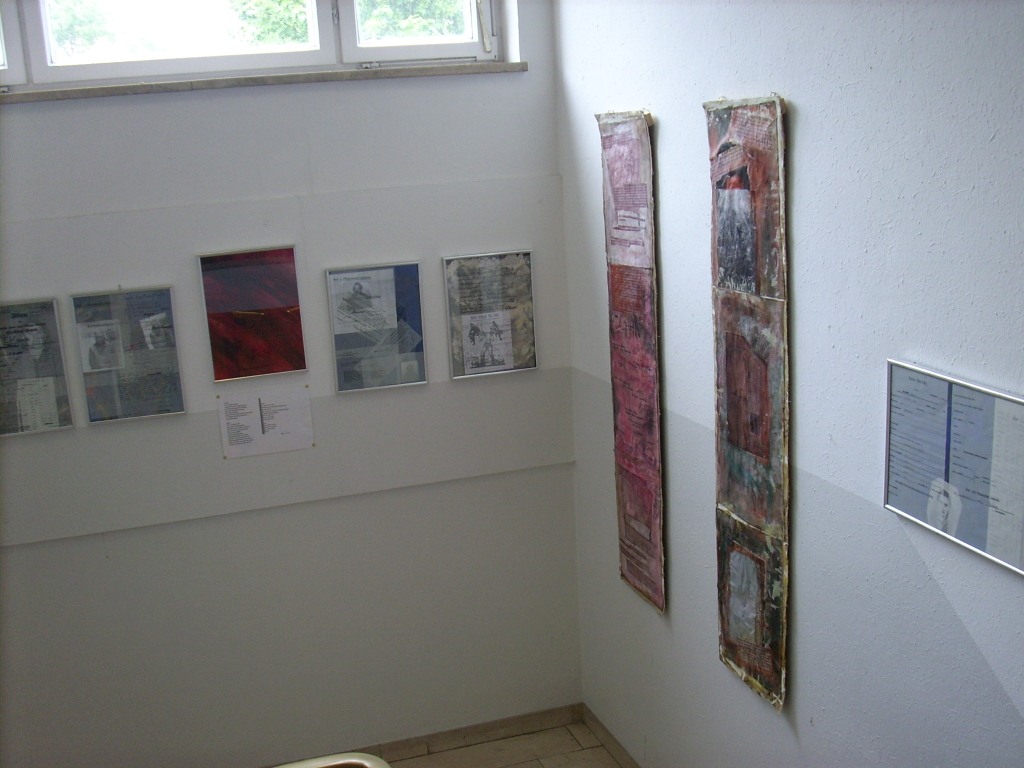 .
.
The clinic museum also has a web site,
where in the clinic history section "euthanasia" crimes are addressed,
and the exhibit section addresses children's euthanasia expressly.
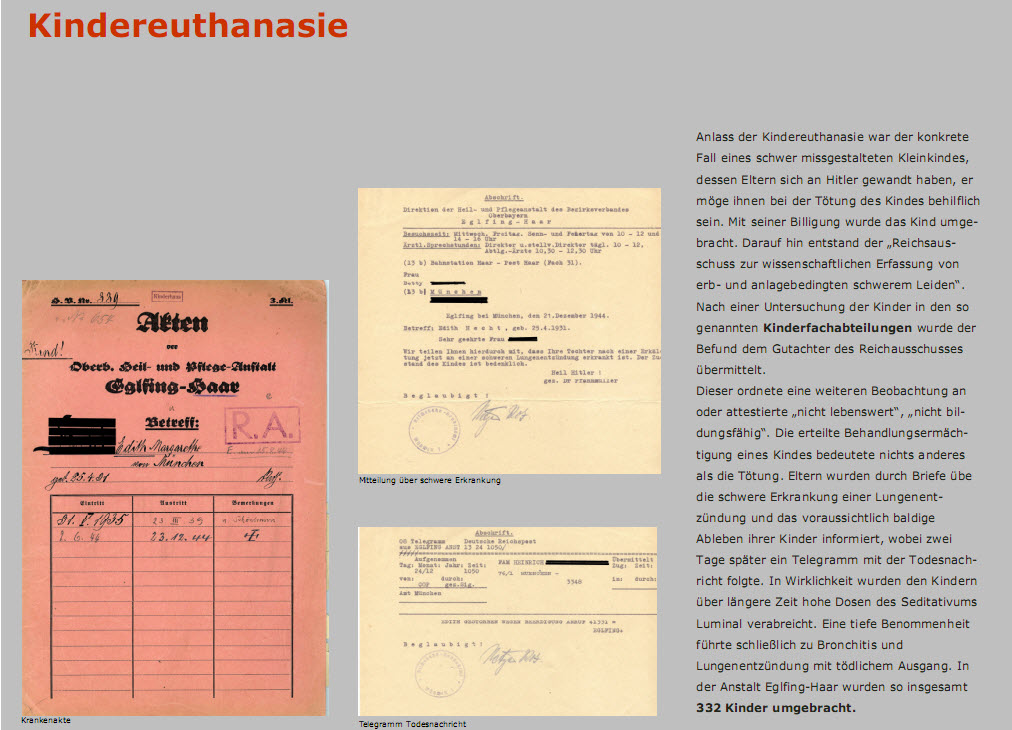
Literature
Alexander, Leo. 1945. "Public Mental Health Practices in Germany:
Sterilization and Execution of Patients Suffering from Nervous or
Mental Disease." Cios Item 24 Medical. Armed Forces Supreme
Headquarters: Combined Intelligence Objectives Sub-Committee.
Benzenhöfer, Udo. 2003. "Genese
und Struktur der
'NS-Kinder- und Jugendlicheneuthanasie.'" Monatsschrift für Kinderheilkunde
151: 1012-19.
Krischer, Markus. 2006. Kinderhaus: Leben und Ermordung
des Mädchens Edith Hecht. Munich: Deutsche Verlags-Anstalt.
Michler, Rainer and Gabi Forcht.
1984. „Morde an geisteskranken Kindern und Jugendlichen in Haar.“
Türspalt
10: 29-36. Available at http://www.kulturkritik.net/psychiatrie/haar/index.html.
Richarz, Bernhard. 1987. Heilen, Pflegen, Töten: Zur
Alltagsgeschichte einer Heil- und Pflegeanstalt bis zum Ende des
Nationalsozialismus. Göttingen: Verlag für Medizinische
Psychologie.
Rückert, Klaus. 2009 (September). Personal communication.
Schmidt, Gerhard. 1965. Selektion in der Heilanstalt,
1939-1945. Stuttgart: Evangelisches Verlagswerk.
———. 2005. "Das unerwünschte Buch." Pp. 3-10 in Aktuelle Kernfragen in der Psychiatrie, edited by Felix Böcker and Wolfgang Weig. Berlin: Springer-Verlag.
Stockdreher, Petra. 1999. "Heil- und
Pflegeanstalt Eglfing-Haar." Pp. 327-62 in Psychiatrie im
Nationalsozialismus: Die Bayerischen Heil- und Pflegeanstalten zwischen
1933 und 1945, edited by M. von Cranach and H.-L. Siemen.
Munich: R.
Oldenbourg Verlag.
Topp, Sascha. 2004. “Der
‘Reichsausschuss zur
wissenschaftlichen Erfassung erb- und anlagebedingter schwerer Leiden’:
Zur
Organisation der Ermordung minderjähriger Kranker im
Nationalsozialismus 1939-1945.”
Pp. 17-54 in Kinder in der NS-Psychiatrie,
edited by Thomas Beddies and Kristina Hübener. Berlin-Brandenburg:
Be.bra
Wissenschaft.
———. 2005. "Der 'Reichsausschuß zur
wissenschaftlichen Erfassung erb-
und anlagebedingter schwerer Leiden': Die Ermordung minderjähriger
Kranker im Nationalsozialismus 1939-1945." Master's Thesis in History,
University of Berlin.
Concerning "Euthanasia" trial(s) for this location
Bauer, Fritz et al., eds. 1968-1981. Justiz und NS-Verbrechen: Sammlung deutscher Strafurteile wegen nationalsozialistischer Tötungsverbrechen, 1945-1966. Amsterdam: University Press Amsterdam. Vol. 3, pp. 17ff; vol. 8, pp. 283ff.
Bryant, Michael S. 2005. Confronting the "Good Death": Nazi Euthanasia on Trial, 1945-1953. Boulder: University of Colorado Press. Pp. 192-98.
Freudiger, Kerstin. 2002. Die juristische Aufarbeitung von NS-Verbrechen. Tübingen: Mohr Siebeck. Pp. 272-78.
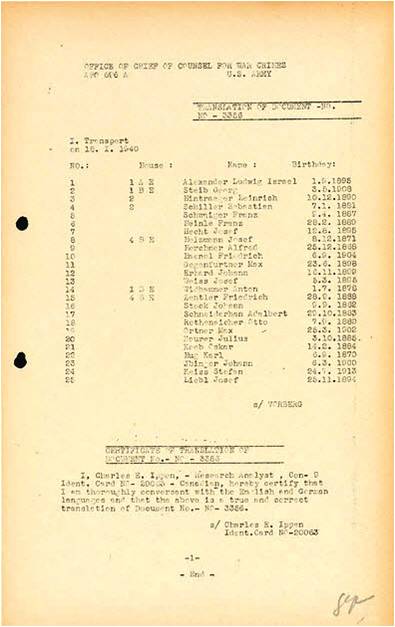

 Source: http://www.bezirk-oberbayern.de/showobject.phtml?La=1&object=tx|379.2695.1&sub=0
Source: http://www.bezirk-oberbayern.de/showobject.phtml?La=1&object=tx|379.2695.1&sub=0
